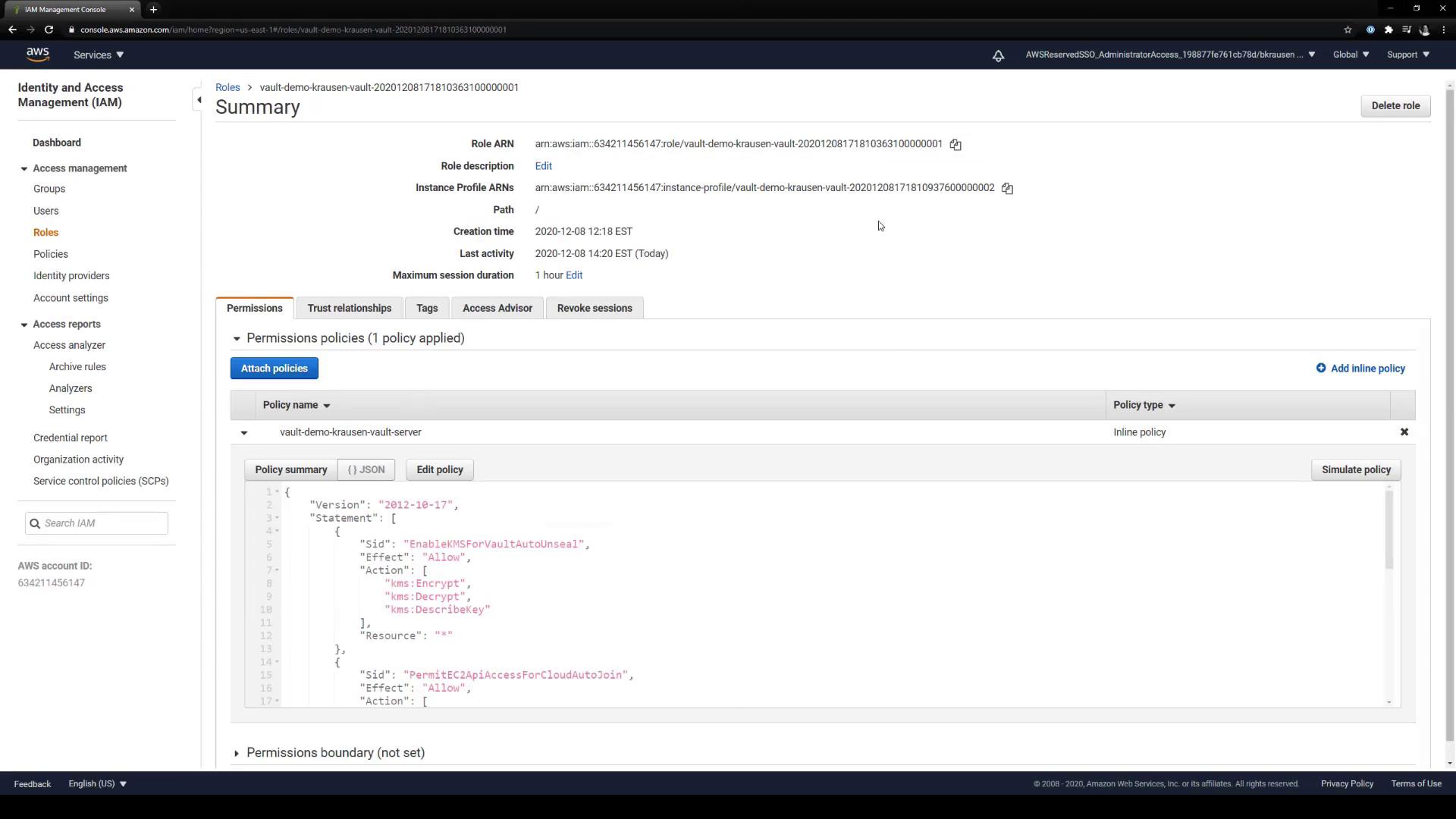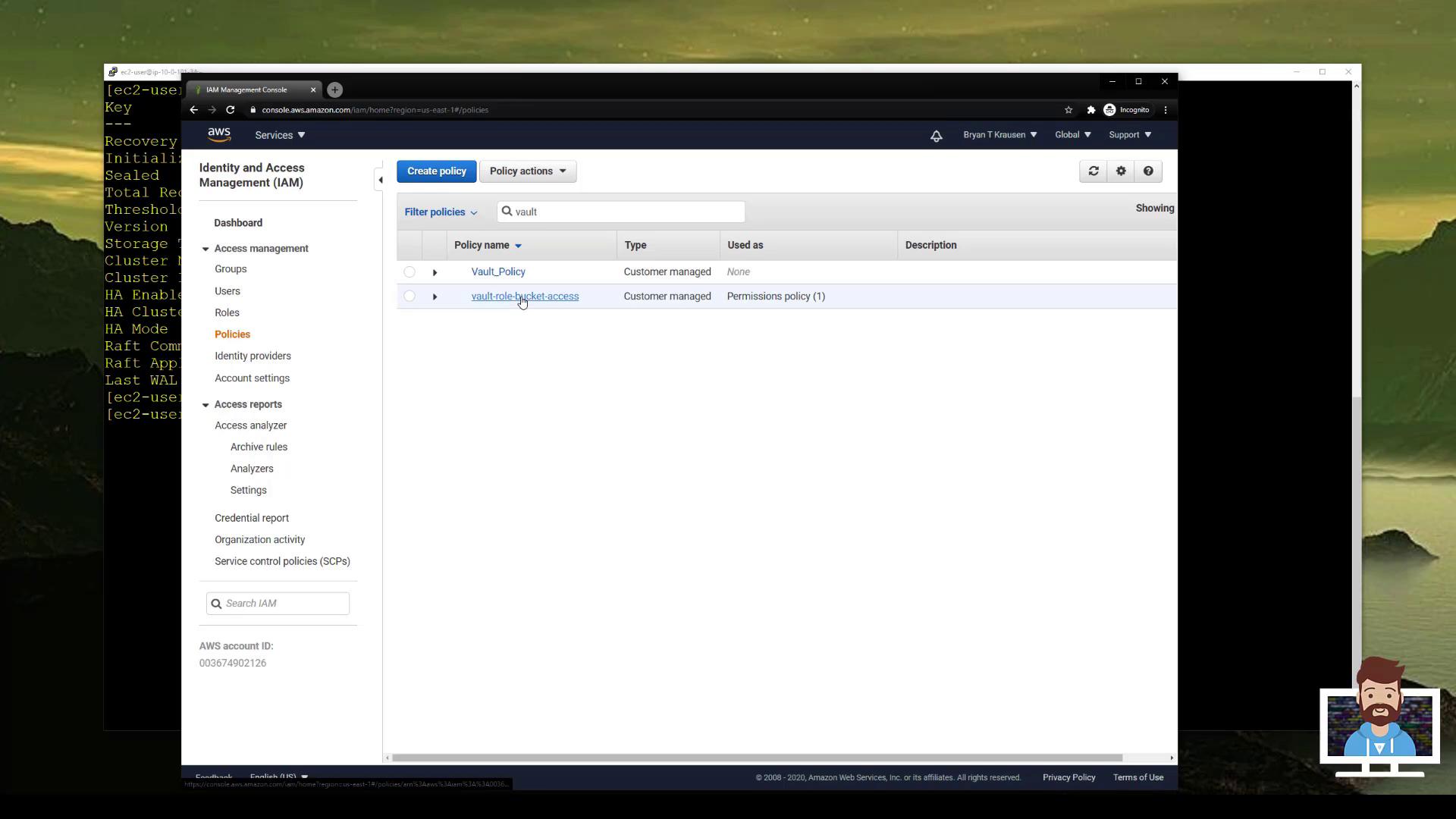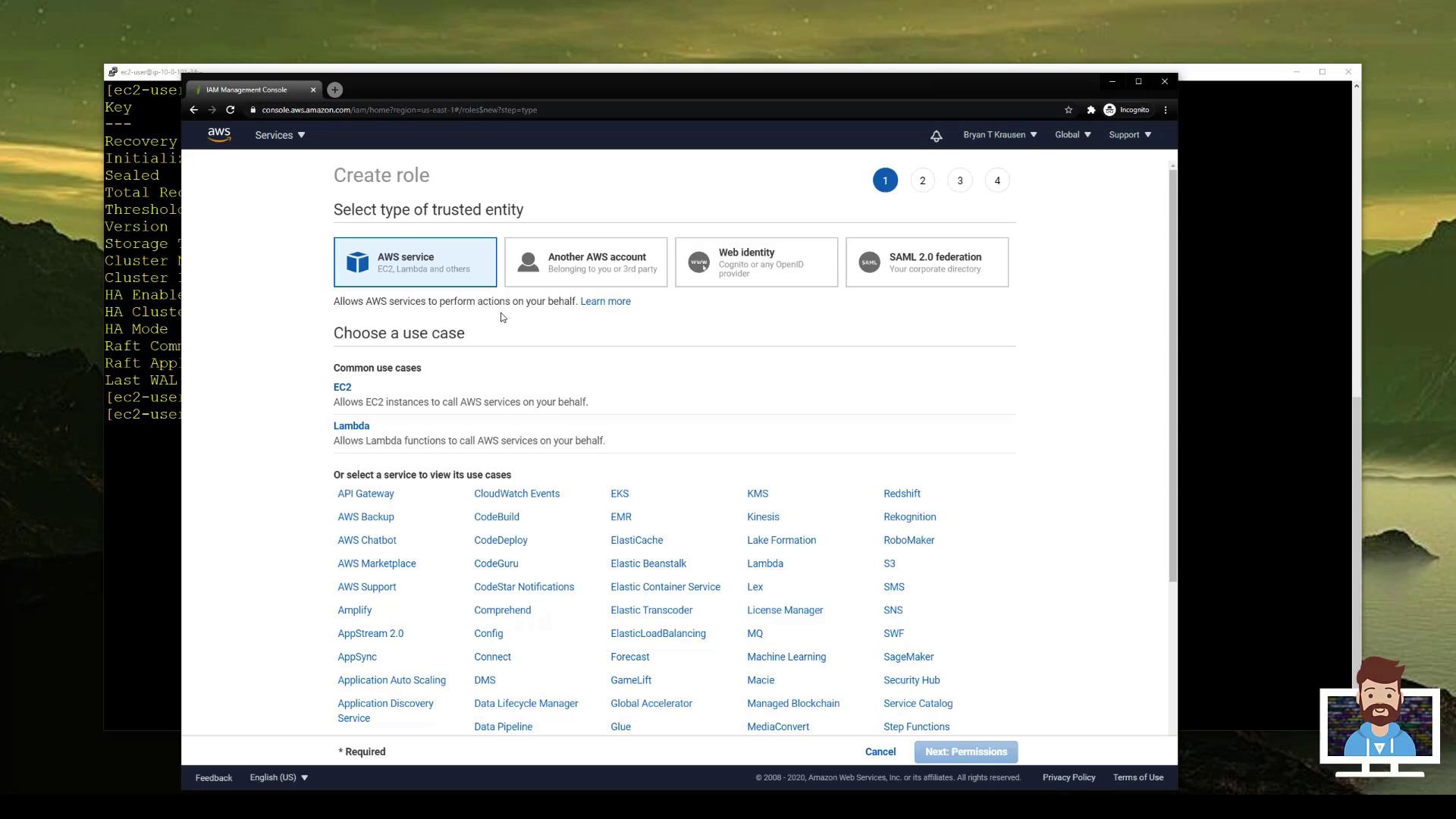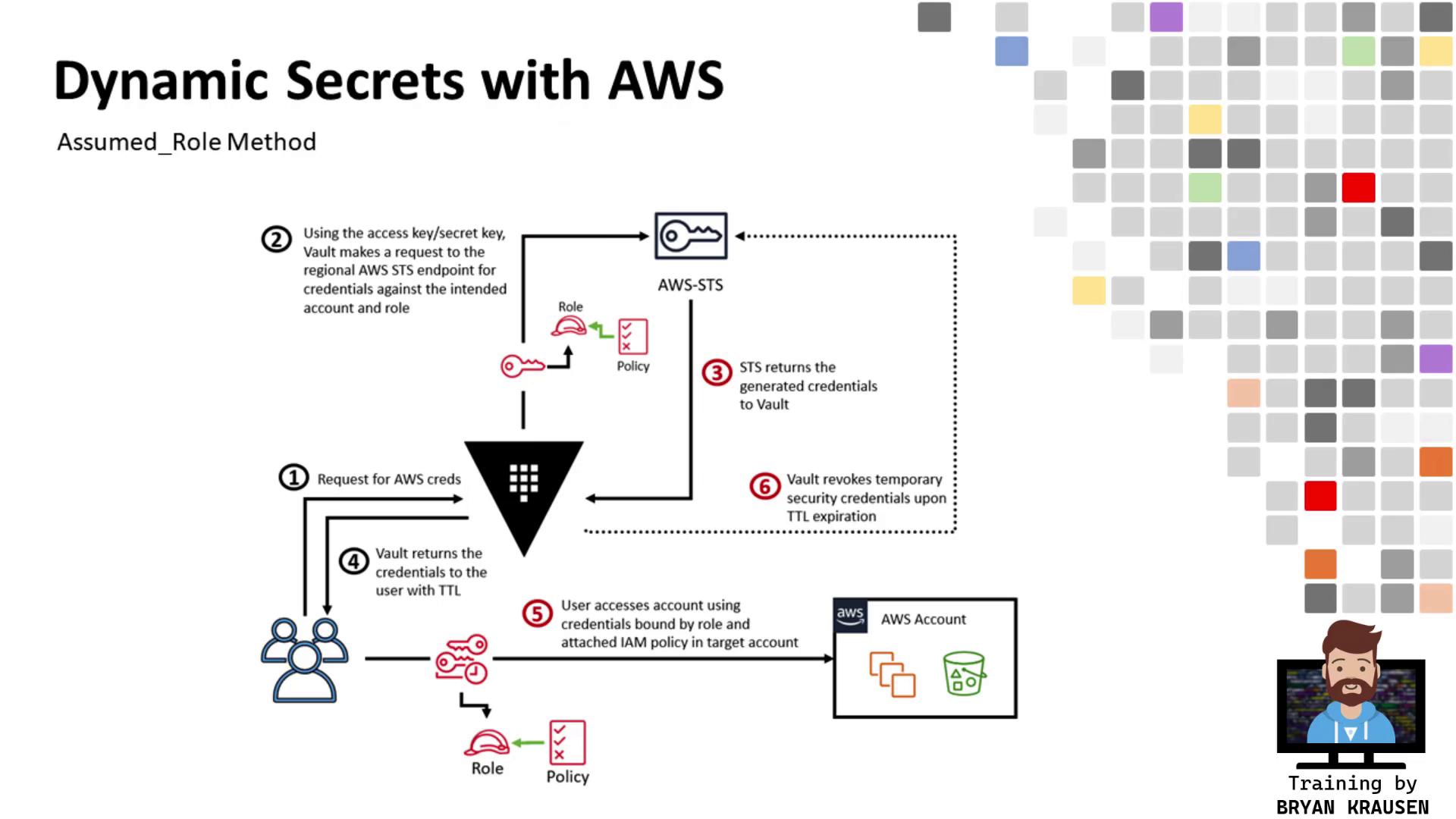HashiCorp Certified: Vault Associate Certification
Compare and Configure Secrets Engines
Demo AWS Secrets Engine Assumed Role
In this guide, you will learn how to configure HashiCorp Vault’s AWS Secrets Engine using the assumed_role credential type to obtain temporary, cross-account AWS credentials. Vault runs in Account A (ID ending in 6147) and will assume a role in Account B (ID ending in 2126) to generate scoped credentials.
Table of Contents
- Verify Vault Cluster Health
- Prepare Target AWS Account (Account B)
2.1 Inspect Existing Role (Optional)
2.2 Create a Customer-Managed Policy
2.3 Create a Role Trusted by Vault’s Account - Enable & Configure AWS Secrets Engine
- Define Vault Role for Cross-Account Access
- Generate & Use Temporary Credentials
- Flowchart
- Conclusion
- References
1. Verify Vault Cluster Health
First, ensure your Vault cluster in Account A is initialized, unsealed, and active.
vault status
Expected output:
Key Value
Initialized true
Sealed false
Version 1.6.0+ent
Storage Type raft
HA Enabled true
IAM Role Permissions for Vault EC2 Nodes
Attach a policy to your Vault EC2 instances that permits required AWS API actions:
| Sid | Effect | Action | Resource |
|---|---|---|---|
| PermitEC2ApiAccessForCloudAutoJoin | Allow | ec2:DescribeInstances | * |
| PermitRoute53AccessForLetsEncryptValidation | Allow | route53:GetChange, route53:ListHostedZones | * |
| PermitActionsForCloudWatchLogs | Allow | logs:CreateLogGroup, logs:CreateLogStream, logs:PutLogEvents, logs:DescribeLogStreams | arn:aws:logs:us-east-1:634211456147:log-group:vault_audit_logs:* |
{
"Statement": [
{
"Sid": "PermitEC2ApiAccessForCloudAutoJoin",
"Effect": "Allow",
"Action": ["ec2:DescribeInstances"],
"Resource": "*"
},
{
"Sid": "PermitRoute53AccessForLetsEncryptValidation",
"Effect": "Allow",
"Action": ["route53:GetChange", "route53:ListHostedZones"],
"Resource": "*"
},
{
"Sid": "PermitActionsForCloudWatchLogs",
"Effect": "Allow",
"Action": [
"logs:CreateLogGroup",
"logs:CreateLogStream",
"logs:PutLogEvents",
"logs:DescribeLogStreams"
],
"Resource": "arn:aws:logs:us-east-1:634211456147:log-group:vault_audit_logs:*"
}
]
}
2. Prepare Target AWS Account (Account B)
In Account B, you will create an IAM policy and role that Vault in Account A can assume.
2.1 Inspect Existing Role (Optional)

2.2 Create a Customer-Managed Policy
Navigate to IAM > Policies > Create policy in the AWS Console and add S3 access permissions:
{
"Version": "2012-10-17",
"Statement": [
{
"Effect": "Allow",
"Action": [
"s3:GetObject",
"s3:ListBucketVersions",
"s3:ListBucket",
"s3:GetObjectVersion"
],
"Resource": [
"arn:aws:s3:::bryankrausen/*",
"arn:aws:s3:::bryankrausen"
]
},
{
"Effect": "Allow",
"Action": ["s3:ListAllMyBuckets", "s3:ListBucket"],
"Resource": "*"
}
]
}

2.3 Create a Role Trusted by Vault’s Account
- Go to IAM > Roles > Create role.
- Select Another AWS account as the trusted entity and enter Vault’s Account ID (
...6147). - Attach the policy you just created (e.g., vault-role-bucket-access).
- Name the role
vault-role-bucket-accessand complete creation.


3. Enable & Configure AWS Secrets Engine
Back in Account A, enable and configure Vault’s AWS Secrets Engine.
vault secrets enable aws
Success! Enabled the aws secrets engine at: aws/
Next, update the IAM role policy attached to your Vault servers to permit assuming the new cross-account role:
{
"Sid": "PermitAccessToCrossAccountRole",
"Effect": "Allow",
"Action": "sts:AssumeRole",
"Resource": [
"arn:aws:iam::083674922126:role/vault-role-bucket-access"
]
}
Apply your changes (for example, via Terraform):
terraform apply
Apply complete! Resources: 0 added, 1 changed, 0 destroyed.
Note
To support multiple target roles or accounts, add additional role ARNs to the Resource array in the PermitAccessToCrossAccountRole statement.
4. Define Vault Role for Cross-Account Access
Create a Vault role that references the IAM role in Account B:
vault write aws/roles/s3_access \
role_arns=arn:aws:iam::083674922126:role/vault-role-bucket-access \
credential_type=assumed_role
Success! Data written to: aws/roles/s3_access
5. Generate & Use Temporary Credentials
Generate STS credentials with a 1-hour TTL:
vault write aws/sts/s3_access ttl=1hKey Value lease_id aws/sts/s3_access/abcdef123456 lease_duration 1h access_key ASIAQBWYRKXZMN3NMZ secret_key /gqnjob/P9E/Kg+Wi2nGKAJ6M79iYlMszAUg2 security_token FQoGZXIvYXdzEJr//////////wEaDM...Export credentials to your shell:
Linux/macOS:
export AWS_ACCESS_KEY_ID=ASIAQBWYRKXZMN3NMZ export AWS_SECRET_ACCESS_KEY=/gqnjob/P9E/Kg+Wi2nGKAJ6M79iYlMszAUg2 export AWS_SESSION_TOKEN=FQoGZXIvYXdzEJr//////////wEaDM...Windows PowerShell:
SET AWS_ACCESS_KEY_ID=ASIAQBWYRKXZMN3NMZ SET AWS_SECRET_ACCESS_KEY=/gqnjob/P9E/Kg+Wi2nGKAJ6M79iYlMszAUg2 SET AWS_SESSION_TOKEN=FQoGZXIvYXdzEJr//////////wEaDM...Use the temporary credentials:
aws s3 ls2021-08-01 12:00:00 bryankrausen 2021-07-30 09:15:12 krausen-cloudtrail 2021-07-25 17:45:08 vault-advanced
6. Flowchart

7. Conclusion
You have successfully configured Vault’s AWS Secrets Engine to assume a role in a separate AWS account, generate temporary credentials scoped to that role’s permissions, and consume those credentials to perform cross-account operations. This architecture is highly scalable—simply extend the IAM policy and add Vault roles for additional accounts or use cases.
8. References
Watch Video
Watch video content